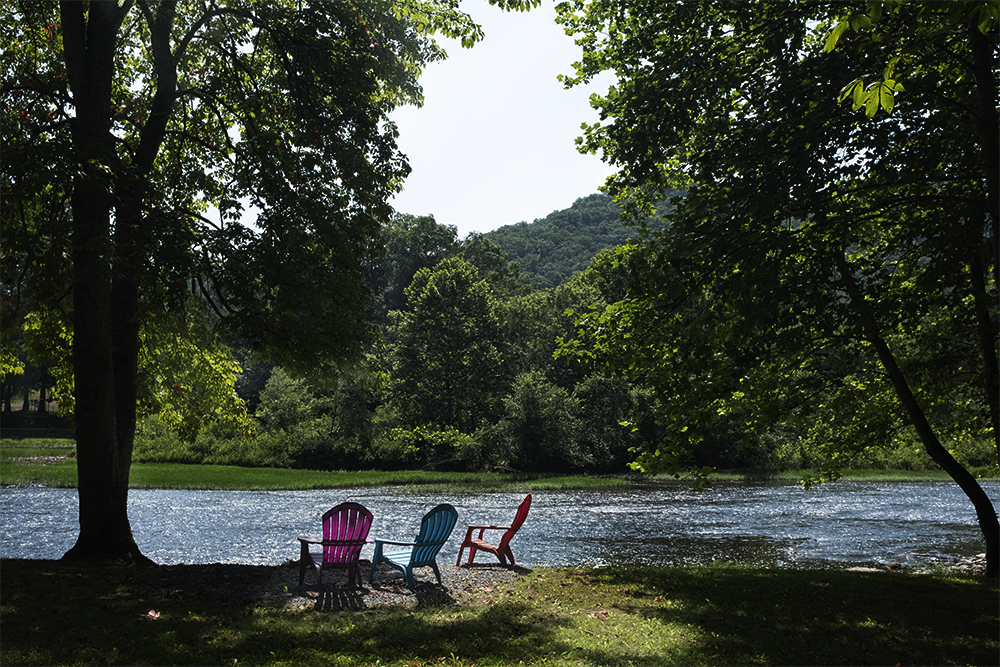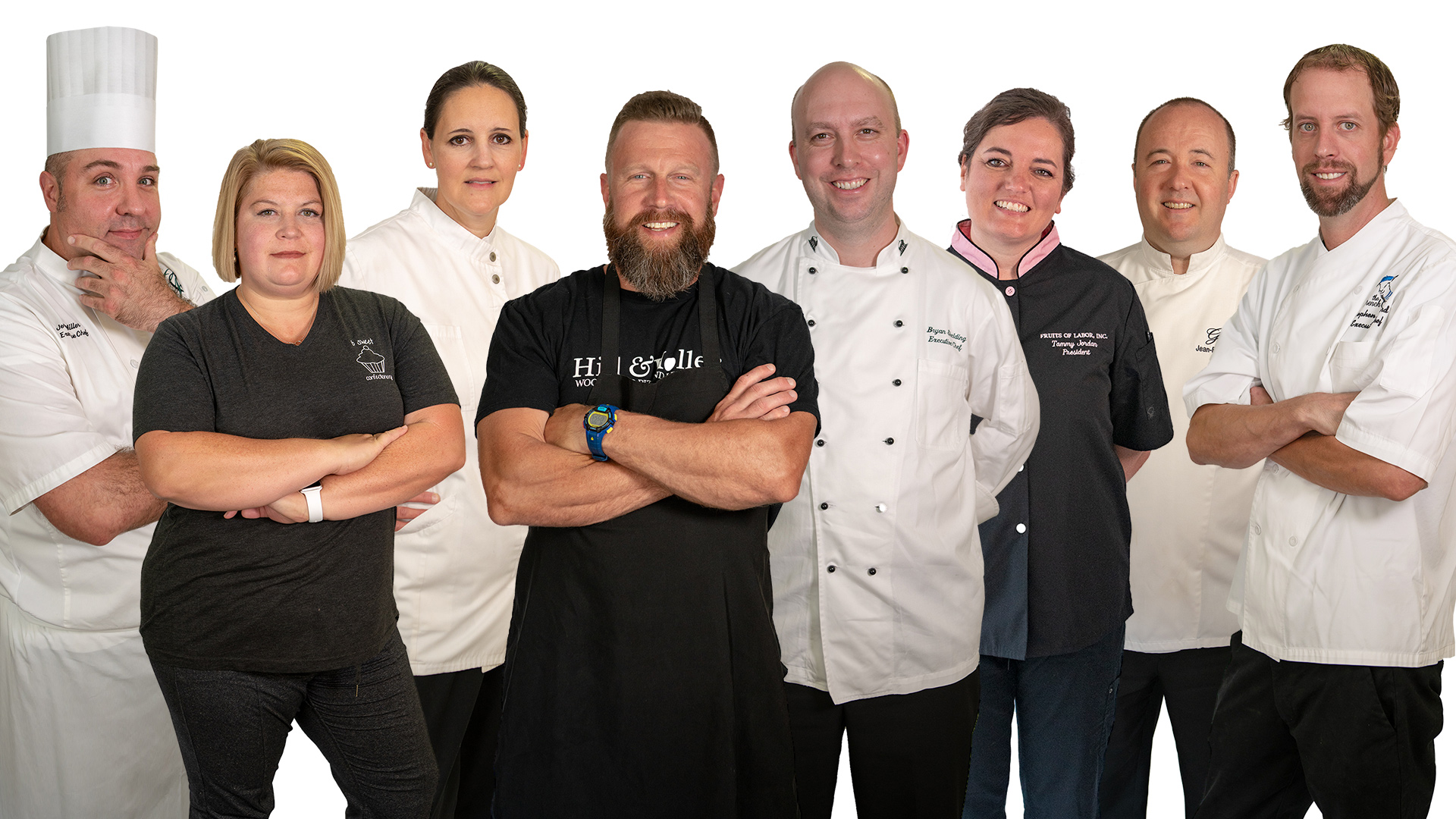Glass at The Greenbrier

Story by Amanda Larch
Photos by Sheena Pendley
Hanging in the Virtu Glass hot shop at The Greenbrier is a little chalkboard that otherwise might be considered inconspicuous, listing items and tools the glassblowers need or are running low on, but on the top of the board someone has written, “The future belongs to those who believe in the beauty of their dream.”
Amidst the heat and noise in the shop, where only well-trained ears can hear one another, and where I can barely hear the processes the glassmakers are explaining, these artists who love and believe in their craft are living proof of that quote’s truth.
Alex Brand is one of those artists, who says his life is a series of miracles. For 11 years, he has been master glassmaker and owner of Virtu Glass at The Greenbrier. But without their home in New York burning down, Brand and his wife would not have packed up their wares and made their way to the Mountain State to find success here. This, believe it or not, is one of Brand’s miracles. He’s able to see the silver lining in just about everything—a talent every good artist should have—and his faith plays a major role in his life and art.
Located in the artist’s colony at The Greenbrier, Virtu Glass—which added a hot glass studio, or the hot shop, as Brand would say, in 2013—allows visitors like myself to witness the miraculous creations of house artists through glassblowing, fusing and sandblasting. Visitors can often take classes themselves as well.
Meanwhile, back at the glass blowing studio, Brand and Max Clair, a glass instructor, work like a well-oiled machine, each sensing and anticipating the needs of the other. Wearing protective gloves and sunglasses, the pair are creating one last pumpkin for the day. It’s going to be green, rolled in a powder that looks almost suspiciously like food coloring added to granulated sugar to achieve the right hue. The molten glass is formed into the shape of a pumpkin, complete with a stem and leaf. This beautiful piece of glassware, like most of Brand’s creations, is to be sold at one of the galleries at The Greenbrier. Other items for sale include drinkware, vases, home décor and ornaments.
“I like making functional things, like bowls, vases, goblets: things people will use,” Brand said.
He’s always had a knack for art and making things, but it was a high school ceramics teacher who really pushed Brand to pursue art as a career. Brand attended the Tyler School of Art, at Temple University, where he majored in jewelry making and metalworking. At the time, glassblowing was relatively new on a small studio scale and wasn’t offered as a major at the Tyler School, but Brand still took some glasses. Having spent his professional career as a glassmaker, Brand still put his degree to use by marrying a jeweler, Susan Chapman Thomas. She does the jewelry work for the gallery at The Greenbrier.
After years of traveling art shows as their main source of income, and losing their home in the fire, he and his wife moved to West Virginia and opened the Virtu shop at the Greenbrier with some help through connections of their art show days.
“My wife was friends with Tom and Kathy Yuri who have the leatherworking shop here,” he said. “They said, ‘Oh, you want to come down to the Greenbrier and open a shop there,’ but we didn’t know anything about the Greenbrier. My wife’s actually from West Virginia; we lived up in Corning, New York, at the time. I had a shop similar for a while and then I worked at Corning for a while, too. We eventually planned on coming to West Virginia because I really loved it here. We decided what the heck, so we came down here to give it a try.”
While Brand doesn’t miss the days of packing up glassware, traveling to craft shows and hoping to make sales, he reminisces on the friends he would see at the shows.
“What I like best is that I’m not traveling with it anymore,” he said. “If you can imagine packing all the glass up in a van and maybe a trailer too and with the whole display and driving somewhere, which could be even a day or two away, setting it all up for three or four days and then packing it all up and doing that maybe 10 times a year, all those years, it really gets tiring. I haven’t done a craft show since we moved here.”
Brand sometimes approaches his craft by experimentation. Certainly, he studies what others make and gets inspiration from nature, but he’s particularly interested in seeing what the glass itself will do and the shapes it’ll take on. One particular series he created—Pagoda vases—were inspired by Japanese architecture.
“I’ve done series at times that were based on more natural things, like different textures, but for me it’s more about just trying different things,” he said. “Sometimes I’ll have an idea to try something, and it won’t go anything like I thought, but I’ll get an idea to go in a different direction. I do some sculptural things at times.
“I occasionally look at historical glass, but I’m more influenced probably by getting ideas from working with a glass. There’s a full range of things. If it’s fall, I’ll take inspiration from fall colors to make my mixes of colors,” he said. “Or just real classical forms as far as the vases and bowls go. I do some vases that I call ribbon vases where they’re set up in a certain way but in the final heat, the way glass moves, I just let the glass do more of what it wants to do than what I want it to do. So it ends up with more of an organic form to it, and people seem to really like that.”
Someone once told Brand he should have a T shirt that says ‘plays well with colors.’ He really enjoys working with color and form. One piece he points out to me in the gallery is solid purple on top with stripes of purple underneath: a perfect example of what he likes to make best. The top and bottom were blown separately and fused. Both are heated and stuck together when they’re at their smallest and blown out further, allowing Brand to get a real clean separation between colors.
“I like combining a lot of different colors. I use a technique a lot called collamore, which is blowing separate parts and then fusing them up and blowing them further. If I’m known for anything, it would be that process, but I do a lot of different processes,” he said.
The most challenging pieces Brand has made were the trophies for a PGA tournament hosted at the Greenbrier, and they’re also some of his favorite pieces.
“The Greenbrier hosted a PGA tournament here for several years. For three of the years I made the trophy for it,” he said. “There’s a number of pieces that I wish over the years I hadn’t sold. The first trophy that I made for the Greenbrier, I think I had probably over 100 hours in that, is made with a lot of different parts that are fabricated and put together with a high tech adhesive.”
One of Brand’s other favorite pieces he designed is a beautiful stained glass artwork featuring a Celtic cross. Because it fit so perfectly in his window, Brand wished he could keep it, but a need for fundraising caused him to pray about what he should do; his prayer was answered, and he auctioned off the stained glass.
“Oh man,” he said. “I don’t keep many pieces, but I wanted that one.”
The art of glassblowing has a rich history in West Virginia, but with only a couple factories still in operation here, and the technological advances available for glass to be produced on a small scale as opposed to a factory scale, Brand believes it’s important to get younger generations interested in glass.
“There’s a lot of historical techniques and history that would be nice to keep going—it’s not good to lose that,” he said. “Especially with more and more advances in technology, automation and artificial intelligence, to think of something, draw it out, and actually make it, take it through the whole process, I think it’s getting more and more unique these days.”
Glassblowing allows Brand a lot of freedom in his creativity, and no day is the same as any other, which is what he likes best about his craft.
“When I lived up in Corning, I knew people who were designers for Corning Incorporated,” he said. “One woman was complaining to me that it took almost a year for something to go from the initial concept to the finished product, and she said it was really frustrating. Whereas I can wake up in the morning and have an idea and say, ‘Okay change of plan, we’re going to do this today.’”
Working in glass for about 44 years has certainly taken its toll physically. Brand has had four surgeries for carpal tunnel and on his trigger fingers. But he tells me this with a laugh. Brand is thinking about retiring, but he’ll forever be thankful for The Greenbrier. Clair is considering taking over the business, and Brand would still make it a habit to stop by the hot shop every now and again.
“I’m extremely grateful that The Greenbrier’s here, that they continue to make a viable business out of it and attract guests,” he said. “They’ve been very lenient, letting us do what we want, not overseeing us too much. It’s nice to see Max (Clair) doing it and give lessons; he’s extremely good at the lessons, and he’s a good people person. Look where I get to come to work every day, it’s a really beautiful place. I try to be grateful every day as I drive in.”
Brand offered additional advice for up-and-coming artists and shared why he believes he has been successful.
“You have to have an aptitude for it, of course. I think there’s still plenty of room for creativity in it. It’s what you feel called to do,” he said. “I don’t know if I’ve worked as smart at it as I could have at first; when I decided to do it, I really didn’t have a plan B, and I just decided I’m going to work as hard as I need to make this work. But I’ve been much more successful in the last 11 years being here than I was prior. I think it’s mainly because of tithing, and that’s a miraculous process that makes the rest go a lot further. Lots of miraculous things have happened because of that.”









